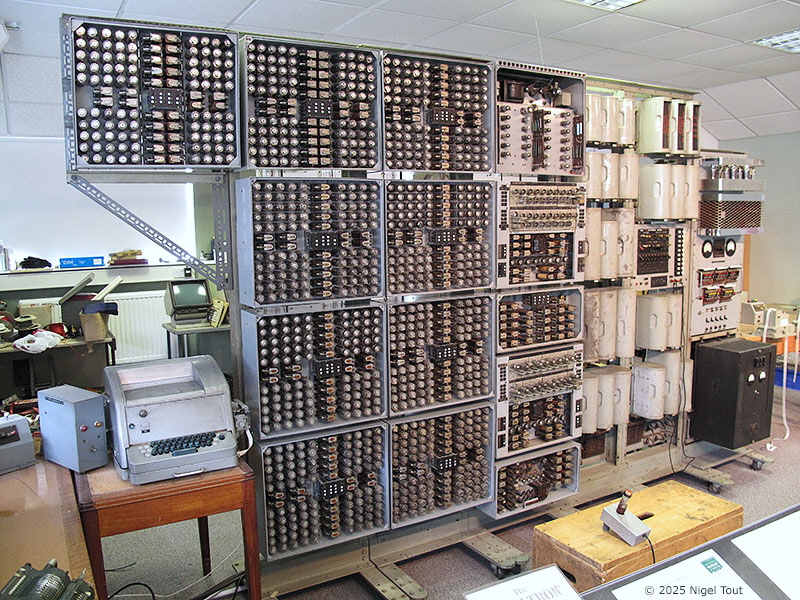Home > Bletchley Park
Bletchley Park &
The National Museum of Computing
A goal of this site is to illustrate the ingenuity in the development of calculators from the large mechanical models, through the early desktop electronic models, to credit-card sized electronic models.
In a similar way, the exhibits at Bletchley Park and the The National Museum of Computing (TNMOC) illustrate the ingenuity in the development of machines to decipher encoded messages culminating in 1944 with Colossus, one of the first electronic computers - and there are interesting calculators on display there.
At one time the Bletchley Park estate featured WWII code-breaking displays side by side with computing exhibits. The entrance ticket gave access to both and the code-breaking guided tours reached a climax with a visit to the electronic 'Colossus' rebuild.
Unfortunately this has now changed and the Bletchley Park museum and the computing exhibits of The National Museum of Computing are separate and you must visit them individually. It is probably best to visit the main Bletchley Park site first for an introduction to the Axis powers' codes and ciphers of WWII and how they were initially broken using brain power, simple aids, and complex mechanical machines. This can then be followed by a walk round the corner to TNMOC to see the 'Heath Robinson' and 'Bombe' rebuilds, and the 'Colossus' rebuild for breaking the most secure codes. Colossus was one of the first electronic computers and is very impressive.
As well as the rebuilds, TNMOC has displays of vintage calculators, vintage computers, and some hands-on working early personal computers.
Note that displays may have changed since these photographs were taken
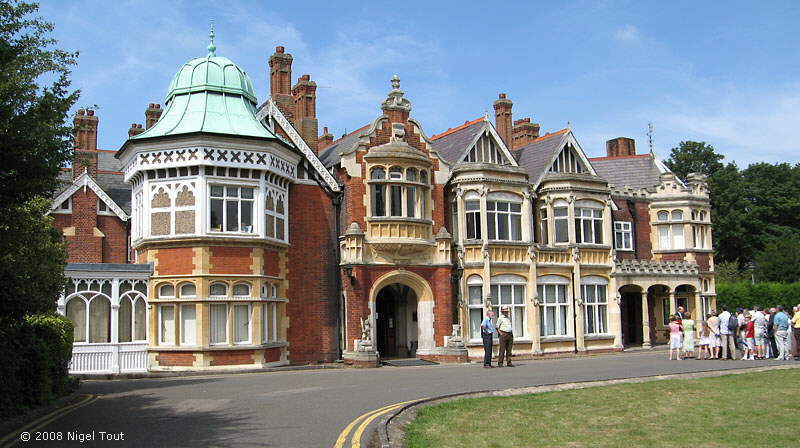
A group of visitors to Bletchley Park listen attentively to their tour guide in front of the Mansion.
Signs of War
In 1938, with signs that a war was getting closer, the Bletchley Park estate was bought by Sir Hugh Sinclair, the Director of Naval Intelligence and the
founder of the Government Code and Cypher School (GCCS). In August 1939 members of the GCCS started to arrive at Bletchley Park and occupied rooms in the Mansion. Their task was to intercept and decipher coded radio
messages sent by the Axis powers (Germany, Italy, and Japan) in the forthcoming war.
Bletchley Park was a suitable location for this work since it lies on the outskirts of Bletchley, then a small country town safely 40 miles north of London, at the junction of a main railway route to the north and the cross-country line linking Cambridge and Oxford Universities.
Soon all room in the Mansion was taken up and the overflow was accommodated in wooden huts which were built on the estate near to the Mansion. Personnel to break the codes of intercepted radio messages were recruited especially from the leading universities and were brought to Bletchley Park to work on their task in great secrecy.
Enigma and the Bombes
The main effort at the beginning of the war was to decipher messages which had been enciphered using one of the
models of the legendary Enigma machines. These hand-operated machines, somewhat resembling large typewriters, were used to scramble plain language messages into what appeared to be a random sequence of letters. However,
when the scrambled sequence of letters was received (after being sent by radio using Morse code) and entered into another Enigma machine set up in an identical way then the original plain language message would be revealed.
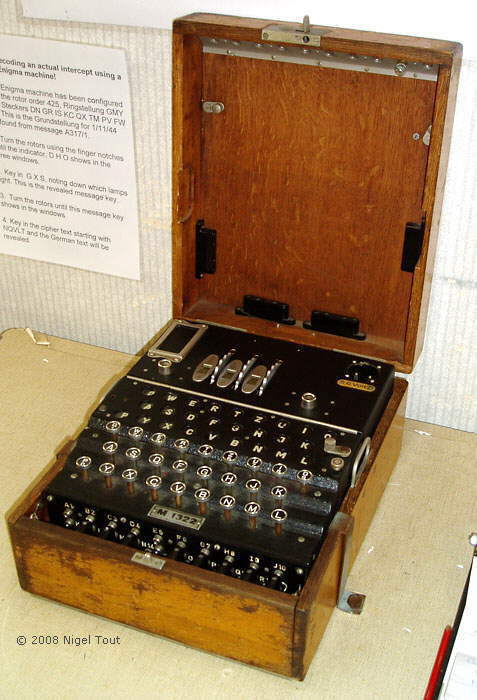
A three-rotor Enigma machine.
The Polish intelligence service had passed on information about the Enigma machine and had demonstrated methods of tackling the breaking of its encryption to the British and French just before WW II started. Their manual methods were developed further at Bletchley Park as the war progressed, and great effort had to be used as the Enigma machines were further enhanced to improve the security of the messages.
Among the academics recruited from universities was Alan Turing who was a pioneer in the field of what was to become known as Computer Science. He had invented the concept of the 'Turing Machine', a general purpose computer that is capable of performing any calculation which it is possible to write down. Turing was one of those highly involved in the development of the 'Bombe', an electro-mechanical machine that was used in the process of breaking Enigma messages.
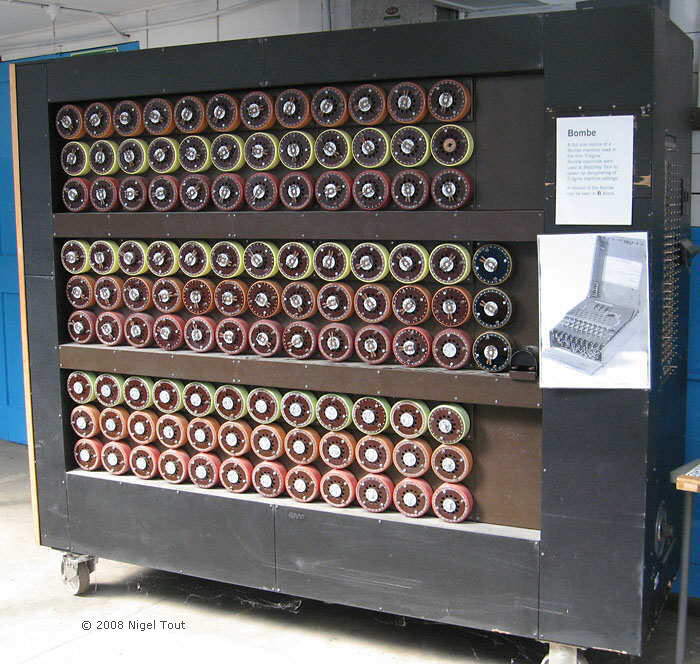
A film prop model of a Bombe used in the feature film "Enigma".
Bletchley Park opens to the public
After the end of World War II Bletchley Park was used by various government agencies, including the GPO,
GCHQ, and the Civil Aviation Authority (CAA).
However, by 1992 the site was nearly completely vacant and, since Bletchley was part of the Milton Keynes development area, the park was proposed for development. Fortunately Milton Keynes Borough Council declared most of the Park a conservation area (where development is restricted) and the Bletchley Park trust was formed to maintain the site as a museum devoted to the code breakers. So in 1993 the site opened to visitors.
Excellent exhibitions have been assembled showing how encryption was used and the story of cryptanalysis at Bletchley Park. With the curtain of secrecy having been lifted many of the people who worked at Bletchley Park have returned and told their tales of the time, have helped the Trust in creating the displays, and have acted as tour guides.
Visiting Bletchley Park
At the Bletchley Park code-breaking museum there is much to see, as well as guided tours about the various code-breaking operations on the site and occasional lectures.
It is open daily (except 24, 25, 26 December).
For more information visit the website at https://www.bletchleypark.org.uk/.
Wikipedia has additional information about Bletchley Park and its exhibits at en.wikipedia.org/wiki/Bletchley_Park
The National Museum of Computing
In 2007 the computer museum at Bletchley Park was
expanded and was relocated next to, and included, the Colossus rebuild in Block H of the Bletchley Park site, becoming The National Museum of Computing (TNMOC). Among items on display are the Bombe rebuild, the Colossus
rebuild, main-frame computers, early personal computers (which are up and running for visitors to experience using), and around 50 vintage calculators.
Important note: although located next to each other on the site at Bletchley, The National Museum of Computing and Bletchley Park are completely separate entities with their own opening times and ticketing.
The first use of automation for helping to decrypt coded messages was with the electro-mechanical 'Bombe', which was used in the decryption of messages produced by Enigma machines. A reconstructed Bombe is on display in TNMOC.
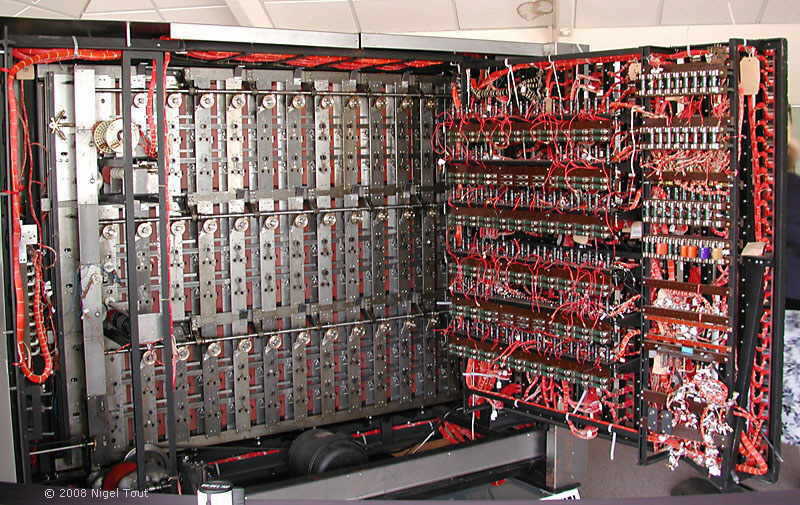
Inside the Bombe rebuild, showing the large numbers of mechanical and electrical components.
Tunny and Colossus
The most significant of the TNMOC exhibits is the fully functional 'Colossus' Mk II which was reconstructed by a team led by Tony Sale.
After great effort this Colossus rebuild was completed with help from some of the original designers, engineers' notebooks, some hardware and drawings which escaped destruction, and documents released in the U.S.A. (which had been
provided with information about it). Since Colossus used standard GPO telephone system components as far as possible the reconstruction has largely been able to source the original types of components.
The Development of Colossus
After periods of difficulty early in the war Bletchley park became very proficient at breaking Axis powers' messages encoded by Enigma machines and it was
claimed that often they would have the plain language message for reading before the proper recipients had. The deciphered messages were passed on to allied intelligence under the name 'Ultra' (from Ultra Secret) but the
source was only disclosed to a very few people for fear of the enemy finding out that its messages were being intercepted and read.
As the war progressed the radio listening stations in Britain began to pick up messages that they realised were being sent by machine and not by human Morse operators. These messages had been enciphered by one of several types of 'Geheimschreiber' (Secret Writer). These operated on somewhat similar principals to the Enigma machines but were much more sophisticated with more rotors and operated automatically on messages originating on teleprinter machines. Bletchley Park gave the generic code name name 'Fish' to this type of message. Whereas most Enigma traffic was of a tactical nature to and from fighting units, by analysing sending and receiving stations the Fish traffic was seen to be of a more strategic nature between the Axis high command. Thus it was highly desirable, but would prove to be extremely difficult, to decrypt the Fish messages.
Bletchley Park took on the task of attacking messages sent using the Lorenz SZ40 and SZ42 machines, which they called 'Tunny', since these were used on important communications links. A breakthrough was made in 1941 when a receiving station asked for a long message to be retransmitted because they had not received it properly. The sending operator made the basic error of resetting his machine to the same start conditions and typing the same message but with minor changes, such as using abbreviations. Both messages were received in Britain, their importance was recognised, and William Tutte working at Bletchley Park was able to deduce the structure of the Lorenz machine from them.
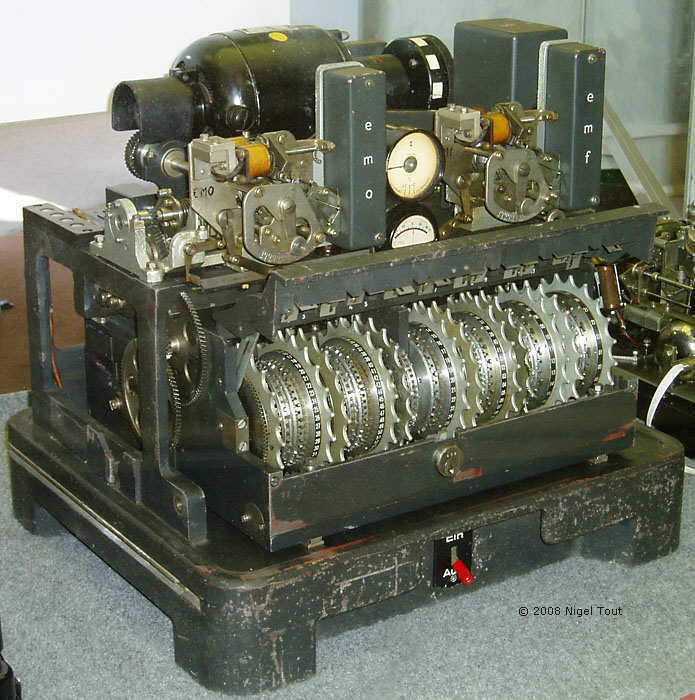
A German Lorenz SZ42 'Geheimechreiber' (secret writer) with cover removed, showing the 12 rotors.
Attempts at breaking Tunny messages using the techniques applied to Enigma messages produced little result and then only after a long time of great effort, by which time the information in the messages was likely to be out of date.
Following on from the use of the Bombe machines in helping to decipher the Enigma messages thoughts were turned to producing more powerful machines to help decode the Tunny messages. Since the machines then being used were electro-mechanical, personnel from the G.P.O (General Post Office, then the operator of the British telephone system) research station at Dollis Hill, in London, were brought in to assist.
The first machine that was developed was called the 'Heath Robinson' (after the cartoonist who drew weird and wonderful machines) and used several paper tapes along with electronic circuits to help determine the settings of the Lorenz machine. Although a great advance, the Heath Robinson machines were still slow and were temperamental.
Tommy Flowers, from the research station at Dollis Hill, proposed a largely electronic machine which would operate faster and more reliably than the Heath Robinsons. Although there was opposition since the machine would use several thousands of vacuum tubes (thermionic valves) which were perceived as unreliable, Flowers pressed ahead at Dollis Hill using his experience with vacuum tubes in experimental telephone switching circuits.
In great secrecy, the first of the resulting 'Colossus' machines was installed in Bletchley Park and started to be used for attacking Tunny messages in February 1944, crucially just ahead of the D-day invasion of Europe by the Allies in June 1944. The machine proved successful and an improved version, the Mark II, was designed and made. The Mk II used 2,400 vacuum tubes and continuously performed logical operations on the received, encrypted, message which was punched into paper tape, formed into a loop, and passed through an optical reader at 30 miles/hour (48 kph). Colossus was the first machine to use shift registers and also systolic arrays (a form of parallel processing). By the end of the war there were 10 Colossus machines in use at Bletchley Park which helped to provide intelligence of incalculable value about the enemy strategy and its forces.
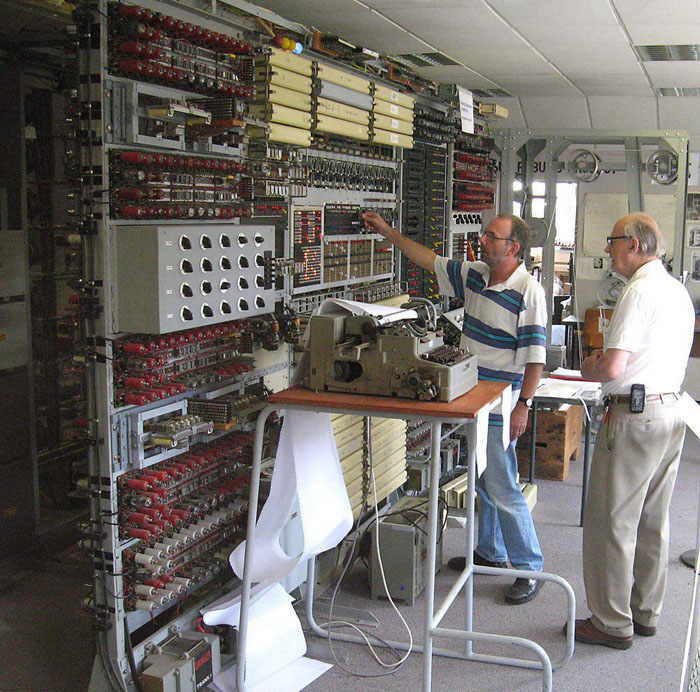
This photograph, taken in 2006, shows the Colossus Mk II reconstructed under the leadership of Tony Sale. Here Tony supervises the breaking of an enciphered message with the completed machine.
The rack in front holds many red-coated vacuum tubes; the second, similar sized rack, can just be seen in the shadows behind. At the far end the paper tape punched with the message to be deciphered travels continuously in an
endless loop round pulleys and past a photoelectric reading head. Colossus performs logical operations on the message to determine the settings of the Lorenz machine that encoded it so that the message can be read on a
similar machine.
This Colossus rebuild is actually in the room in which Colossus number 9 operated in 1945, and is now part of TNMOC.
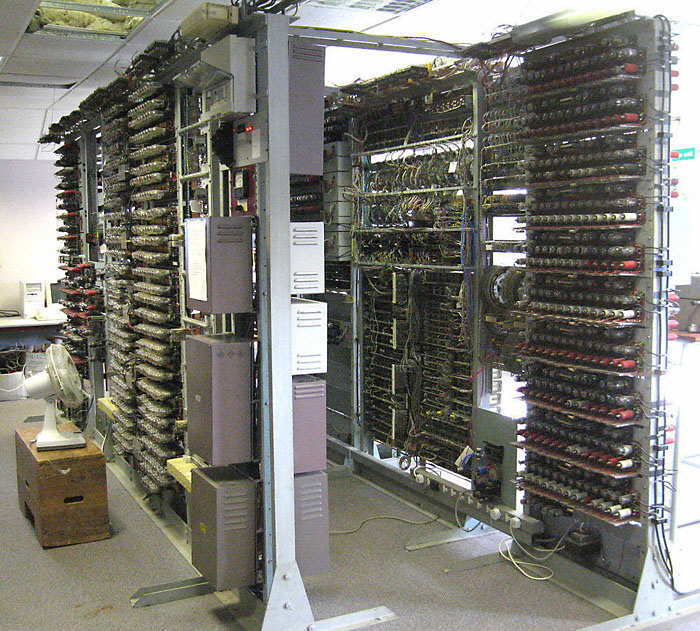
View of the rear of the Colossus rebuild showing the two racks and the large arrays of vacuum tubes, some of which require additional cooling!
An often asked question is "Which was the first electronic computer?". This has no simple answer since all the early machines exhibited some of the features we now demand in a computer, but none had all of these features. In this case, Colossus was not easily programmable, since this was performed using patch cords and switches, and Colossus did not pass the "Turing complete" test, that is it could not be used as a general purpose computer. However, Colossus was one of the most advanced and powerful special purpose computing machines of its time.
Unfortunately, Colossus was top secret and at the end of the war Winston Churchill ordered all of the machines at Bletchley Park and all of the drawings to be destroyed except for the few that were required at the new Government Communications Head Quarters (GCHQ) then being established. All of the staff at Bletchley Park left and were sworn to secrecy under the dreaded Official Secrets Act. The Park and Colossus were unknown to the world for over 30 years until information started to emerge in the late 1970s. Even today, over 80 years later, there is information about Colossus that is still classified as secret, though a 500 page report on Tunny and its decryption was released by GCHQ in 2000.
Calculators and Computers at TNMOC
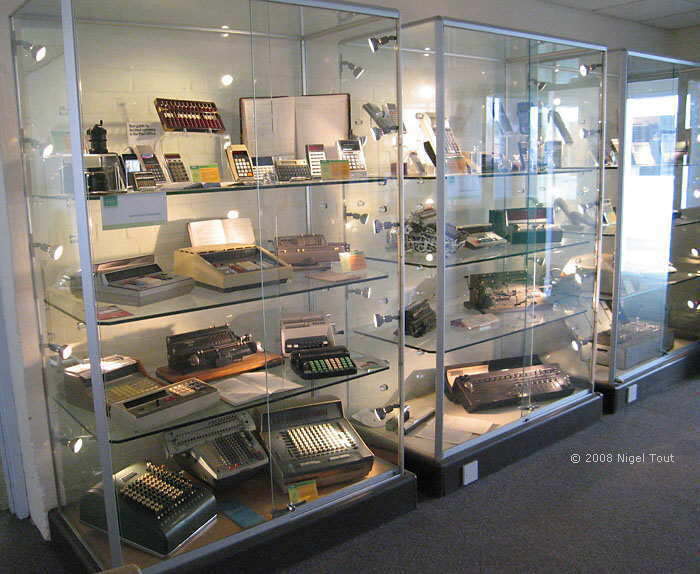
Part of the calculator display in The National Museum of Computing.
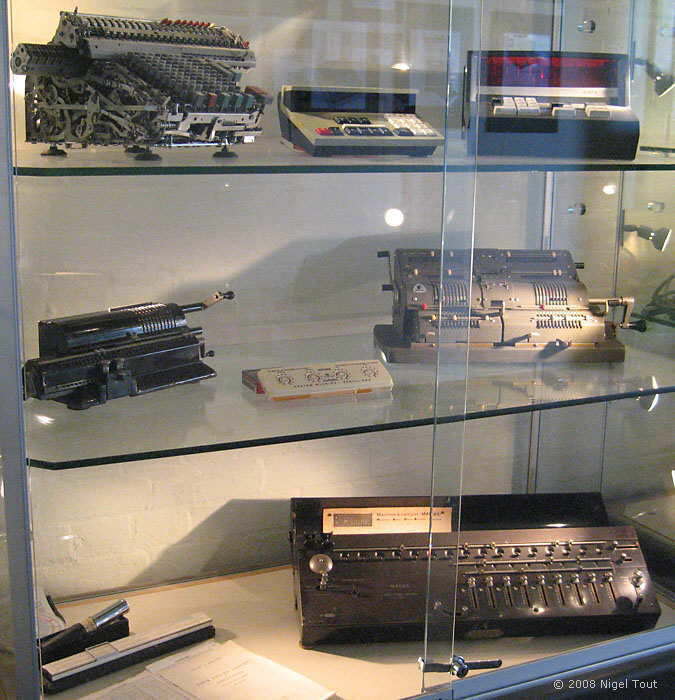
Close up of some of the calculators on display at TNMOC.
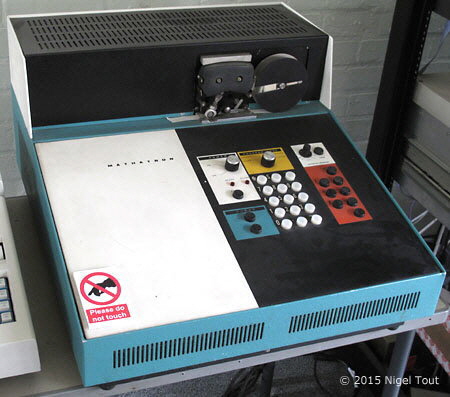
Mathatron early electronic desktop calculator on display at TNMOC.
Some of the hand-held calculators on display at TNMOC.
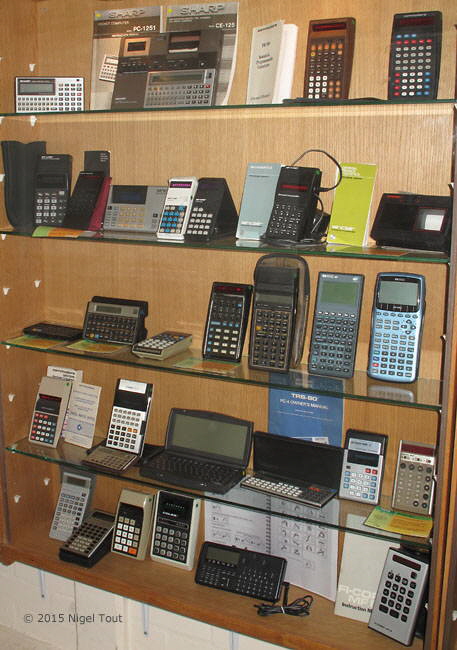
The Harwell Dekatron Computer.
From Wikipedia: "The computer, which weighs 2.5 metric tons (2.8 short tons), was built and used at the Atomic Energy Research Establishment in Harwell, Berkshire. Construction started in
1949, and the machine became operational in April 1951. It was handed over to the computing group in May 1952 and remained in use until 1957.
It used 828 dekatrons for volatile memory, similar to RAM in a modern computer,
and paper tape for input and program storage. A total of 480 relays were used for sequence control and 199 valves (electronic vacuum tubes) for calculations.
From 2009 to 2012, it was restored at the National Museum of Computing. In 2013, for the second time, the Guinness Book of World Records recognised it as the world's oldest working digital computer, following its restoration."
Was knowledge of this use of dekatrons in computing inspirational in their choice for use in the early ANITA calculators?
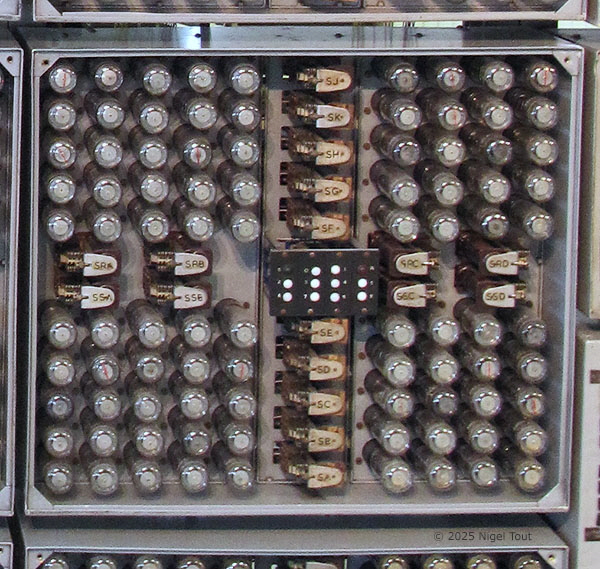
An array of dekatrons in the Harwell Dekatron Computer.
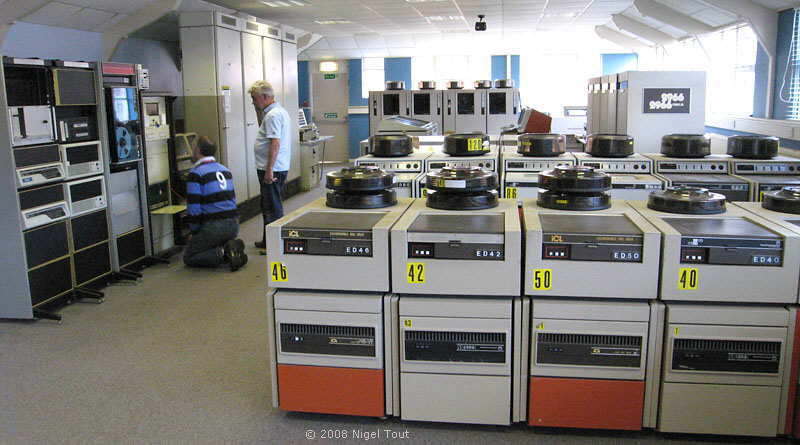
Main-frame and mini computers at The National Museum of Computing.
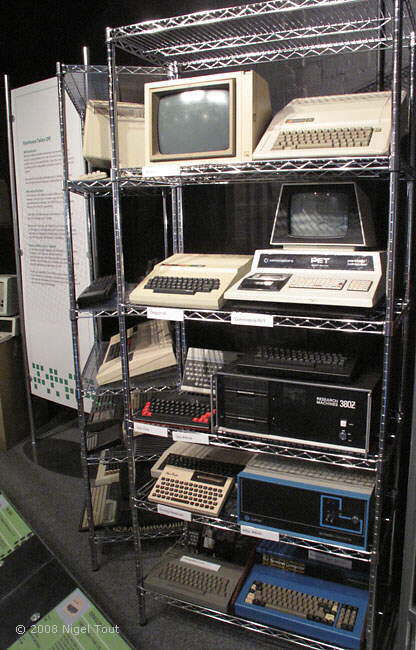
Display of early personal computers at The National Museum of Computing. A selection is often up and running for visitors to try out.
Visiting The National Museum of Computing (TNMOC)
Although on the same general Bletchley Park site, The National Museum of Computing is physically separate from the Bletchley Park museum and has different opening times.
TNMOC aims to open to the public Tuesday, Thursday, Saturday and Sunday - 10:30am - 16:30pm during Winter hours (extended to 17:00pm during Summer hours) - but please check its Days Open page before planning your visit.
For the latest information visit the The National Museum of Computing website.
As always, if you especially desire to see a certain exhibit and before traveling a long distance get in touch with these museums to check that the exhibits concerned are viewable.
3D Virtual Tour
An excellent 3D Virtual Tour The National Museum of Computing has been created. Here you can guide yourself through the rooms and the displays of the museum, including vintage calculators.
Additional Information about The National Museum of Computing (TNMOC)
Wikipedia has additional
information about The National Museum of Computing and its exhibits at en.wikipedia.org/wiki/The_National_Museum_of_Computing
Vintage Calculators
Text & photographs copyright, except where stated otherwise, © Nigel Tout 2000-2026.
